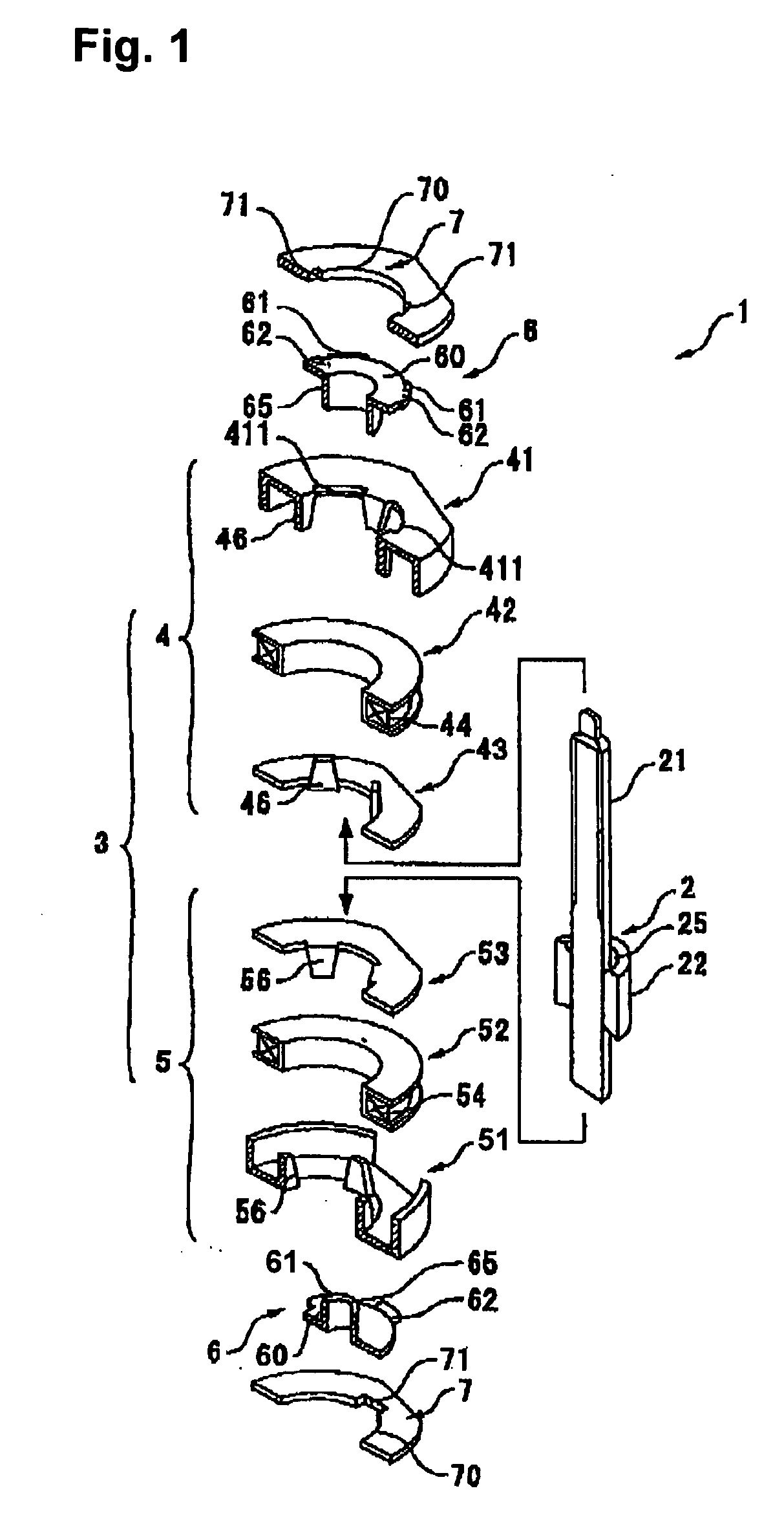Motor with improved rotary shaft supporting structure
a technology of supporting structure and rotary shaft, which is applied in the direction of horology, magnetic circuit shape/form/construction, instruments, etc., can solve the problems of adhesion and other problems, and achieve the effects of high positional precision, high precision and simple structur
- Summary
- Abstract
- Description
- Claims
- Application Information
AI Technical Summary
Benefits of technology
Problems solved by technology
Method used
Image
Examples
first embodiment
[0035]FIGS. 1 and 2 are an exploded perspective view and a longitudinal cross-sectional view, respectively, of a motor according to the first embodiment of the present invention. FIGS. 3(a)-(i) are a plan view, a cross-sectional view and a bottom view of an end plate; a plan view, a cross-sectional view and a bottom view of a bearing plate; and a plan view, a cross-sectional view and a bottom view of a first outer stator core, all used in the motor shown in FIGS. 1 and 2, respectively. FIGS. 4(a)-(f) are a plan view, a cross-sectional view and a bottom view of a state in which the end plate and the bearing plate shown in FIG. 3 are placed together, and a plan view, a cross-sectional view and a bottom view of a state in which the end plate and the bearing plate are mounted on the first outer stator core, respectively.
[0036] As shown in FIGS. 1 and 2, a stepping motor 1 according to the present embodiment is a PM-type stepping motor and comprises a rotor 2 with a permanent magnet 22,...
second embodiment
[0055]FIG. 5 is a longitudinal cross-sectional view of a motor in accordance with a second embodiment of the present invention. FIGS. 6(a)-(i) are a plan view, a cross-sectional view and a bottom view of a second outer stator core; a plan view, a cross-sectional view and a bottom view of a bearing plate; and a plan view, a cross-sectional view and a bottom view of an end plate, respectively, all used in the motor shown in FIG. 5. FIGS. 7(a)-(f) are a plan view, a cross-sectional view and a bottom view of a state in which the end plate and the bearing plate shown in FIG. 6 are placed together, and a plan view, a cross-sectional view and a bottom view of a state in which the end plate and the bearing plate are mounted on the second outer stator core, respectively.
[0056] As shown in FIG. 5, a stepping motor la according to the present embodiment is a PM-type stepping motor like the motor according to the first embodiment and comprises a rotor 2 with a permanent magnet 22, a rotary sha...
third embodiment
[0070] The present invention is also applicable to a stepping motor having a structure shown in FIGS. 8 and 9 among stepping motors whose rotary shaft has a cantilevered structure.
[0071] FIGS. 8(a) and (b) are a longitudinal cross-sectional view of a motor in accordance with another embodiment of the present invention and an exploded cross-sectional view of a part of the motor, respectively. FIGS. 9(a)-(h) are a side view of a rotor, a side view of a steel ball, a plan view of a slide bearing (a bearing member), a bottom view of an outer stator core placed opposite to an output end, a plan view of a bearing plate holding the bearing member, a bottom view of the slide bearing, a bottom view of the bearing plate, and a bottom view of a leaf spring, respectively, all used in the motor shown in FIG. 8.
[0072] In FIGS. 8(a) and 8(b) and FIGS. 9(a)-(h), a stepping motor 1b according to the present embodiment includes a rotor 2, a steel ball 262, which is mounted in a concave section 28 f...
PUM
 Login to View More
Login to View More Abstract
Description
Claims
Application Information
 Login to View More
Login to View More - R&D
- Intellectual Property
- Life Sciences
- Materials
- Tech Scout
- Unparalleled Data Quality
- Higher Quality Content
- 60% Fewer Hallucinations
Browse by: Latest US Patents, China's latest patents, Technical Efficacy Thesaurus, Application Domain, Technology Topic, Popular Technical Reports.
© 2025 PatSnap. All rights reserved.Legal|Privacy policy|Modern Slavery Act Transparency Statement|Sitemap|About US| Contact US: help@patsnap.com



